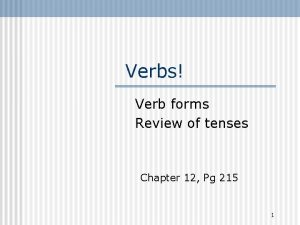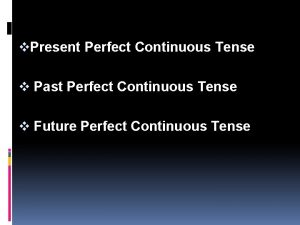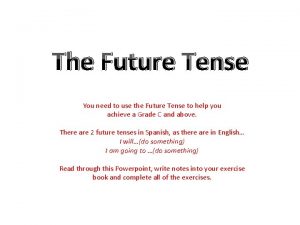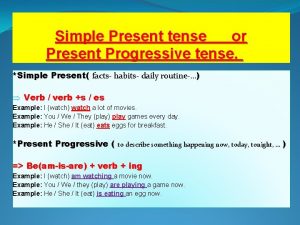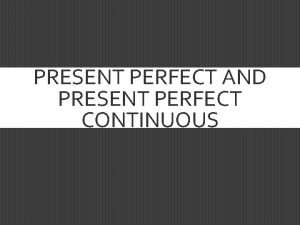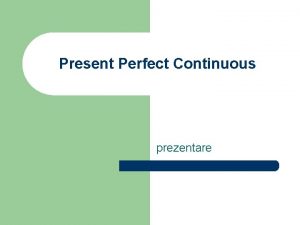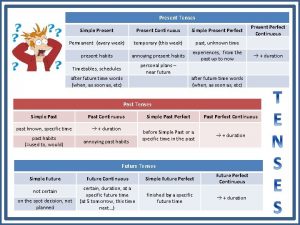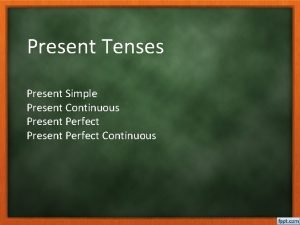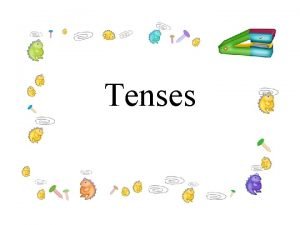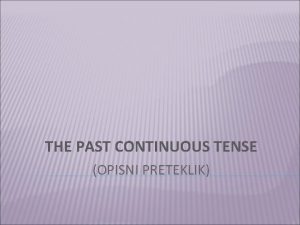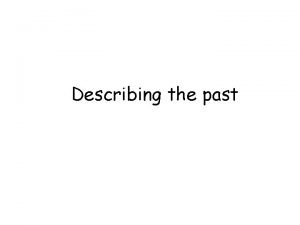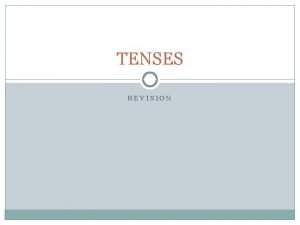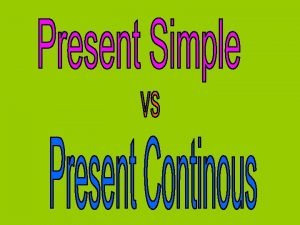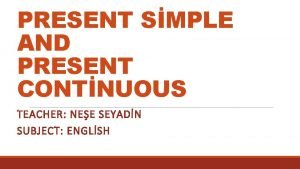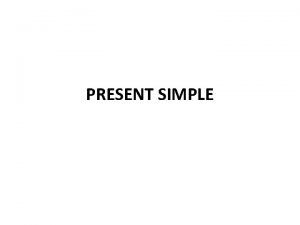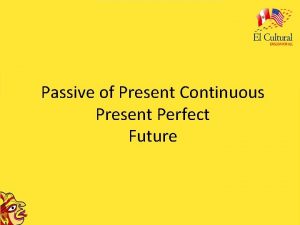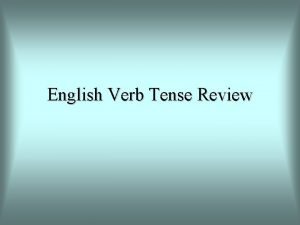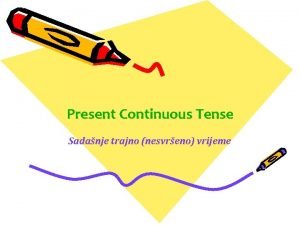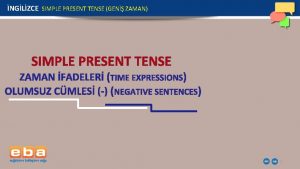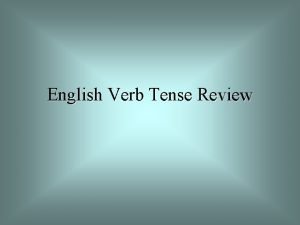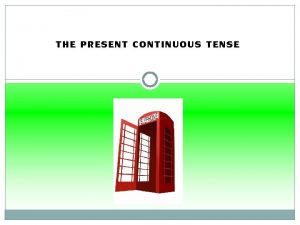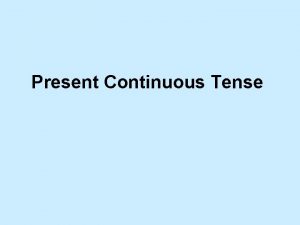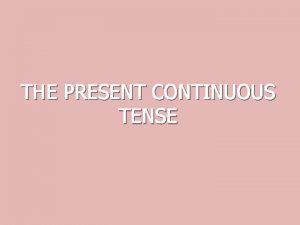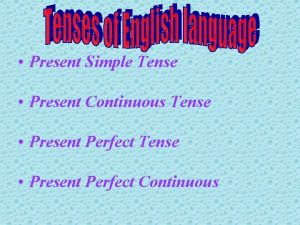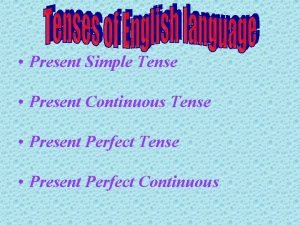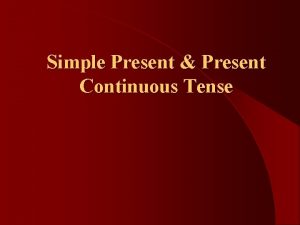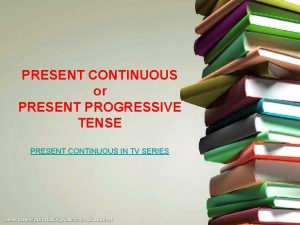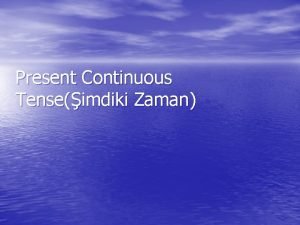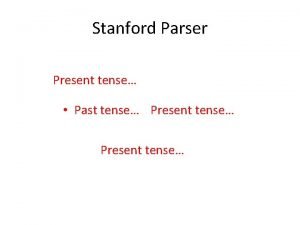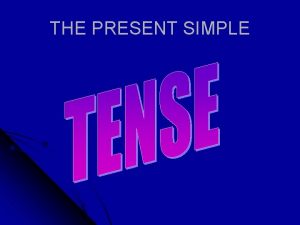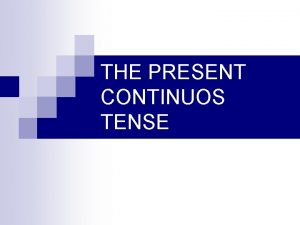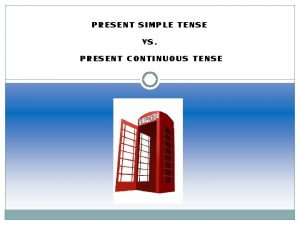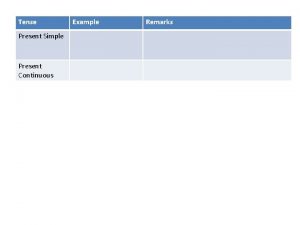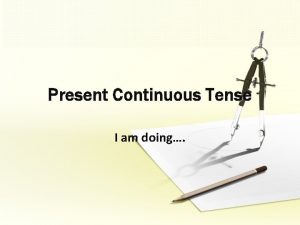THE PRESENT CONTINUOUS TENSE presente contnuo O presente









































- Slides: 41








THE PRESENT CONTINUOUS TENSE (presente contínuo)

O presente contínuo tem esta fórmula: to be + verbo principal com “ing”

Exemplo: I am studying.

NOTE: Para usá-lo corretamente, você vai precisar lembrar: * A conjugação do verbo to be no presente. * As alterações ortográficas dos verbos na forma ing.

Exemplos de uso: They are crossing the street now. I am playing the guitar at this moment. Nowadays she is working in a factory.

Advérbios de tempo que normalmente acompanham:

nnow - agora nat this moment - neste momento n. Nowadays - hoje em dia

INTERROGATIVA E NEGATIVA

n Como o present continuous é formado pelo verbo to be, para formar a interrogativa, coloca-se o verbo to be na frente da frase. E para formar a negativa, acrescenta -se not após o verbo to be.

Ex: Affirmative form: You are studying English. Interrogative form: Are you studying English? Negative form: You are not studying English.

Affirmative form sujeito + to be + verbo principal com “ing“

I am studying you are studying he is studying she is studying

it is studying we are studying you are studying they are studying

Negative form sujeito + to be + not + verbo principal com “ing”

I’m not studying you aren’t studying he isn’t studying

it isn’t studying we aren’t studying you aren’t studying

Interrogative form to be + sujeito + verbo

Am I studying…? Are you studying…? Is he studying…? Is she studying…?

Is it studying…? Are we studying…? Are you studying…? Are they studying…?

Exemplos:

n What are you doing? (O que você está fazendo? ) n Is she studying English now? (Ela está estudando inglês agora? ) n He’s reading a book and I‘m listening to music. (Ele está lendo um livro e eu estou ouvindo música. )

n. Are they swimming at the club? (Eles estão nadando no clube? ) n. Yes, they are. (Sim, estão. ) n. No, they aren’t. (Não, não estão. )

Ortografia dos verbos na forma “ing”

Verbos terminados em e: retirar o e e adicionar ing, por exemplo: 1.

nmake making ntake - taking

2. Verbos terminados em ie: retirar o ie e acrescentar ying, por exemplo:

ndie - dying

3. Verbos monossilábicos com a estrutura consoante 2 + vogal + consoante 1 (da direita para a esquerda)- antes de adicionar o ing, duplique a consoante número 1, por exemplo:

nrun - running nswim - swimming

4. Verbos com duas sílabas e acento tônico na primeira sílaba da direita para a esquerda- antes de adicionar o ing, duplique a consoante número 1 se a estrutura for consoante 2 + vogal + consoante 1, por exemplo:

nbe. GIN – beginning n. MURder - murdering

Adicionar somente o ing aos demais verbos: ntravel - traveling nsleep - sleeping nfall - falling

npush - pushing nwork - working nopen - opening

nstudy - studying nplay - playing ndo - doing ngo - going
 Past present future continuous
Past present future continuous The past progressive
The past progressive Present continuous tense in hindi
Present continuous tense in hindi Present perfect continuous
Present perfect continuous Present perfect tense vs present perfect continuous tense
Present perfect tense vs present perfect continuous tense Present continuous verb
Present continuous verb Be verbs
Be verbs Past simple future
Past simple future Past tense for peel
Past tense for peel Past perfect continuous tense vs present perfect continuous
Past perfect continuous tense vs present perfect continuous Present and past tense
Present and past tense Feature tense
Feature tense Present simple and present continuous exercises
Present simple and present continuous exercises Present progressive tense examples
Present progressive tense examples Present perfect simple and continuous difference
Present perfect simple and continuous difference Present perfect present simple present continuous
Present perfect present simple present continuous Present simple present continuous and present perfect
Present simple present continuous and present perfect Present perfect continuous schema
Present perfect continuous schema Present perfect continuous passive
Present perfect continuous passive Present simple present continuous present perfect
Present simple present continuous present perfect Tense
Tense Past perfect simple and continuos
Past perfect simple and continuos Present simple past simple future simple
Present simple past simple future simple Past continuous present continuous
Past continuous present continuous Past perfect tense of finish
Past perfect tense of finish Revise present continuous tense
Revise present continuous tense I work you work he works
I work you work he works Smple present tense
Smple present tense Present continuous tense ride a bike
Present continuous tense ride a bike Present perfect continuous tense
Present perfect continuous tense Present simple tense affirmative form
Present simple tense affirmative form Signal
Signal Future perfect simple passive
Future perfect simple passive Present continuous tense subject
Present continuous tense subject Present continuous diagram
Present continuous diagram Present continuous recenice
Present continuous recenice Present progressive用法
Present progressive用法 Geniş zaman zarfları ingilizce
Geniş zaman zarfları ingilizce Auxiliary in simple present
Auxiliary in simple present Past continuous primjeri
Past continuous primjeri Past perfect indicators
Past perfect indicators Simple past and past progressive
Simple past and past progressive






